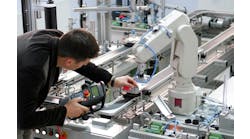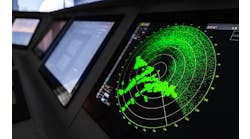The challenge in any design is to incorporate all the features that your customer desires without making a whole new design each time. Previously, I’ve discussed ways we can modularize our designs to leverage the experience we gained in previous projects. While this approach is good, sometimes it can lead to designs that don’t take advantage of the technical advances the hardware itself can provide. A good design is a healthy mix of tried and true with new and innovative.
As a contract packager, we come upon challenges on a daily basis. Some can be solved by reusing solutions from similar opportunities, while others need a new approach. One such application is a means by which to sense product dropping from a quad cup filler. A cup filler uses a rotating disc with cavities cut into it. The circumference of each cavity, or cup, combined with the height of the disc provides a known volume into which a product can be filled. Each time the filler rotates, it moves product from the infeed port to a carry port with one or more of the cavities having a void in the bottom to act as the discharge of the volumetric filler. A quad cup filler is fout independent discs with volumetric cups fed by a common product stream and discharging to four separate output tubes.
The key to successful application of a volumetric cup filler is to ensure that product drops each time the filler cycles. Product often gets caught in the down tube. Sensing a single drop can be done in a number of ways, but one that has worked well for us, is to cut a small through hole in the down tube from the cup filler and use a fork-shaped send/receive optic to monitor product traveling through the tube. The problem with this solution is twofold. First, the product doesn’t necessarily pass through the part of the tube where the sensor pair is mounted. Second, the product tends to build up on the inside of the tube and can, over time, block the beam of the sensor pair. These two concerns can result in frequent visits by maintenance to clear the inside of the tube and to realign the down pipe to get the product back into the sensor pair beam.
A product came across my radar a few years back that provided a great solution to this challenge. Most optic sensors have a single beam that uses either the product or a background reflector to sense the product or a receiver to detect the beam from the sender. The problem with this configuration is you are restricted to the width of the beam. Keyence, long a choice of mine for innovative sensors in a small package, came out with what can best be described as a photo eye that is a light curtain—a ribbon of light instead of a narrow beam. Offered in widths from 5 mm to 100 mm, these curtains split the optic into multiple beams with opposing receivers. The amplifier that interprets the light received back is used to determine how much of the received light constitutes a blocked beam. In this manner, a few blocked beams can be ignored by the amplifier as product trickle, while many blocked beams in an intentional drop of product mass. Using the 100 mm version, I can position this optic array across the down pipe on the cup filler without cutting a hole in the pipe. Rather than using the typical beam blocked or not blocked to sense product, this solution has a setting that makes use of the change in beam intensity to trigger a signal to the PLC. As the down pipe collects product buildup, the sensor is interested only in a change in the beam to sense the passage of product. With that setting, we are able to keep all of the product in the tube, since there are no holes for the beam to pass through, and we can run for much longer before being forced to clean out the inside of the tube.
For anyone who has worked with through-beam optics, or any photo sensor for that matter, the proximity of sensors can cause a phenomenon called cross talk. The blocking of one beam might actually cause the triggering of an adjacent sensor. Keyence has a solution for this, as well. By using a backbone network, multiple amplifiers can be plugged in, similar to PLC modules, across a common connection point. The networked amplifiers have a unique identifier that filters out the “sent” light from adjacent optics so that only its connected pair is responsive. This solution allowed us to put optic arrays on four adjacent down pipes without any interference between the closely mounted sensors.
This product has been a great addition to our stable of solutions, and we have used both the typical blocked beam setup to sense product level in a tube, as well as the one-shot change in intensity setup to detect a package of product dropped through the tube. Always one to innovative, Keyence has come up with a newer version of these optic amplifiers that makes this solution even greater.
In the former version, each amplifier needs a separate cable going back to the control system. Each sensor has its own power, as well as control, analog and digital output signals. In the new version, sensors can be connected to a communications module that requires simply two wires for power and a communications cable to go back to the control system. Think of it as distributed I/O but in a sensor package. With all the features available in the previous model, the new release goes a major step forward with an enhanced user interface on each amplifier. Gone is the seven-segment display in favor of a matrix display that allows for enhanced menus and feedback options. One such display even provides a bar graph of the output response of the optical sensor where the max and minimum settings become the range of the bar graph and the actual output set point is a mark on the bar graph. At a glance, the user can look at a bank of coupled amplifiers and immediately determine if a particular sensor isn’t performing within set parameters.
This new technology is capable of communicating in most of the common protocols, including EtherNet/IP, Ethernet TCP/IP, Profinet, Profibus, Ethercat, DeviceNet, RS-232C, BCD and CC-Link V2. Up to 15 amplifiers can be linked on a single communications module, and batch transmission of signals and settings can be accomplished from either PLC or PC. There is even a non-communications version that allows for coupling up amplifiers with a single cable going back to the control panel, saving on managing multiple cables.
The beauty of this solution is we didn’t have to totally depart from our current controls design. We get to use the same optics with a new and improved data collection method. The older units were harder to set up because the seven-segment display only provided three characters for each of the menu items, while the new system has actual human readable names to clearly indicate each parameter.
A nice sidebar to any visit by your vendor is the opportunity to learn about a new product. While I was being shown the great product upgrade for our existing solution, I had the opportunity to look at a relatively new product on the process side of the spectrum.
We have not traditionally done much in the way of automation on the process side of things, as nearly all of our products requiring primary processing are of a dry nature and can be easily measured by weight. However, we do use some extruded ingredients from time to time, and the proper sensing of these ingredients could use some enhancements. The solution, another Keyence product, uses a non-intrusive sensor that can measure flow and turbidity of a product inside a cavity. The sensor simply straps on to the outside of the process pipe, and a simple teaching of the sensor identifies the near and far side of the inside diameter of the pipe.
A matching sensor on the same mount identifies the same dimensions at a set distance from the first. While this device is a great advance over traditional sensors where one must cut the pipe and insert the sensor into the product stream, the greatest feature is the recent addition of the same communications module as the previous solution, meaning that the set points and feedback can be monitored without the need for additional wiring.
Situations like this are why it is so important to develop a good working relationship with your automation vendors. Regular update visits are a great way to stay on the leading edge of technology, and, as in this case, the changes to your control design can be minimal while the advantages can be great.
Sometimes I find it hard to fit these visits into my busy schedule, but, in nearly every case, I come away from these visits with some piece of knowledge that at least stirs the creative juices and leads to further discoveries. In the case of the visit from Keyence, I got more for less, and that is always a win in control design.






